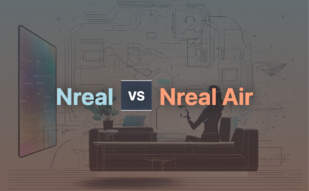For immersive tech fanatics, Virtue One stands superior with its trifecta of AR, VR, and MR technologies and seamless device compatibility. However, budget-conscious innovators may find Nreal more suitable for its fusion of AR and VR capabilities and wider application use.

Key Differences Between Nreal and Virtue One
- Nreal utilizes both AR and VR to produce mixed reality experiences, while Virtue One integrates AR, VR, and MR technologies.
- Nreal functions on devices like smartphones and laptops, while Virtue One specifically requires XR glasses.
- While both are used extensively in gaming and education, Nreal has a broader reach in sectors like software development and graphic design, and Virtue One is recognized in cloud gaming and streaming.
- Virtue One has been praised for superior visual performance, but Nreal’s price point may be better suited to budget-conscious users.
| Comparison | Nreal | Viture One |
|---|---|---|
| Type of Technology | AR/VR | AR/VR/MR |
| Funding/Support | Market projected to reach $209.2 billion by 2022 | Raised over $3m on Kickstarter |
| Device Type | Headsets, smartphones, mixed reality systems | XR glasses with optional mobile dock and neckband |
| Resolution and Frame Rate | Infinite Display with high-resolution graphics | Full HD resolution at 60fps with 50000:1 contrast ratio |
| Use Cases | Gaming, marketing, e-commerce, education, enterprise, healthcare | Cloud gaming, remote console play, streaming; compatible with laptop, smartphone, Nintendo Switch, Steam Deck |
| Extra Features | Eye Tracking, Scene Understanding, stereoscopic color Passthrough | Built-in speakers, diopter dial for focus adjustment, electrochromic film for lens darkening |
| Price | Varies depending on type of device used | Glasses alone priced at $549; launch suite includes all components for $677 |
| Final Reviews Pending | No information available | Yes |
What Is Nreal and Who’s It For?
Nreal is a trailblazing technology company specializing in AR/VR technologies. Its prowess lies in amalgamating Augmented Reality (AR) and Virtual Reality (VR) to derive Mixed Reality systems. Nreal targets tech enthusiasts, software developers, and graphic designers, seeking to revolutionize industries through immersive experiences and interactive digital-physical object interactions.
An AR/VR market steeply climbing for a $209.2 billion threshold by 2022, Nreal has carved a notable presence with innovations like Spatial Anchors, Scene Understanding, and Stereoscopic Color Passthrough. These technologies are transforming AR/VR platforms, making Nreal an intriguing option for aspiring virtual world builders.
Pros of Nreal
- Combination of AR and VR technology, resulting in mixed reality systems
- Recognition of 3D space for heightened interactive experience
- Strong foothold in a blossoming AR/VR market
Cons of Nreal
- Limited to tech-savvy users
- Specialized AR/VR equipment necessary for full experience
What Is Viture One XR Glasses and Who’s It For?
Viture One XR glasses, the best XR glasses currently available, is a feat of modern technology, compatible with AR, VR, and MR. Drawing success from a robust Kickstarter campaign, these glasses serve gaming enthusiasts, enterprise operators, and cloud gamers, attributing versatility to features like remote console play and streaming.
Despite weighing a mere 78 grams, the Viture One XR glasses simulate a 120-inch screen image with Full HD resolution at 60 fps. Combined with a high contrast ratio thanks to micro OLED display, they transform into a portable USB-C monitor compatible with laptops, smartphones, Nintendo Switch, and Steam Deck, among others.
Pros of Viture One XR Glasses
- High compatibility range for different devices
- Lightweight design with a colossal simulated screen image
- Diverse functionalities along with promising upcoming features
Cons of Viture One XR Glasses
- Comfort issues due to design
- High-priced relative to market competitors
The Verdict: Nreal or Virtue One?
In the battleground of augmented and virtual reality technologies, two gladiators emerge: Nreal and Virtue One. Each contains its strengths and offers unique features designed to allure specific audience segments. Let’s decipher each technology’s appeal, segment by segment.
Developers and Game Makers
For those who create immersive experiences, the flexibility and developer-friendly ecosystem provided by Nreal wins the battle. This platform’s Mixed Reality innovation, backed by robust R&D, offers a fertile ground for creating engaging games and applications. Vital features such as Spatial Anchors and Scene Understanding open avenues for advanced game creation.

eCommerce Entrepreneurs
If eCommerce is your forte, the Virtue One shines brightly. Its capacity for switching seamlessly between devices and streaming support, courtesy of its planned neckband, makes it an excellent companion for creating interactive shopping experiences. The high contrast ratio and picture quality add finesse to product showcases.

Education Experts
Education experts seeking to revolutionize learning, listen up: Nreal is your new classroom. From star identification to complex healthcare procedures, Nreal’s AR capabilities can supplement traditional learning methods with interactive and practical sessions, driving effectiveness to new heights.

When it comes to the tech battle of Nreal vs Virtue One, for developers, game makers, and education experts, Nreal’s sophisticated mixed reality environment offers endless possibilities. However, for eCommerce entrepreneurs seeking a seamless, immersive showcase, Virtue One’s perceptibly real visual experience is unmatched.
Tiffany Brise
Content writer @ Aircada, patiently awaiting a consumer AR headset that doesn’t suck.





